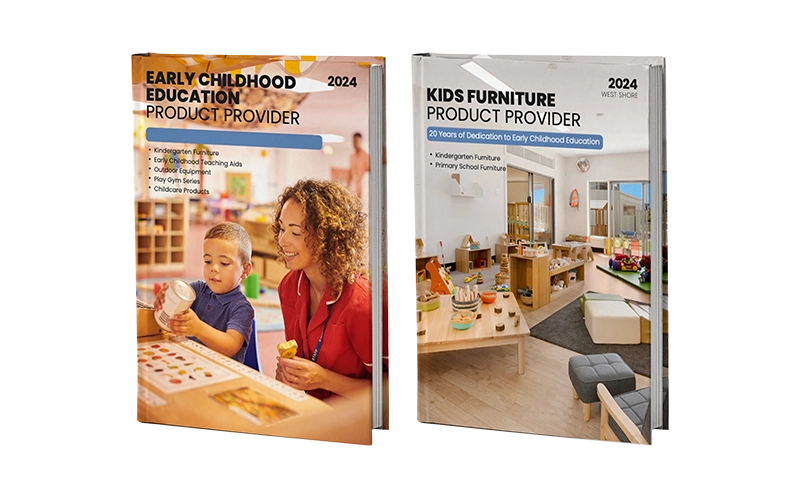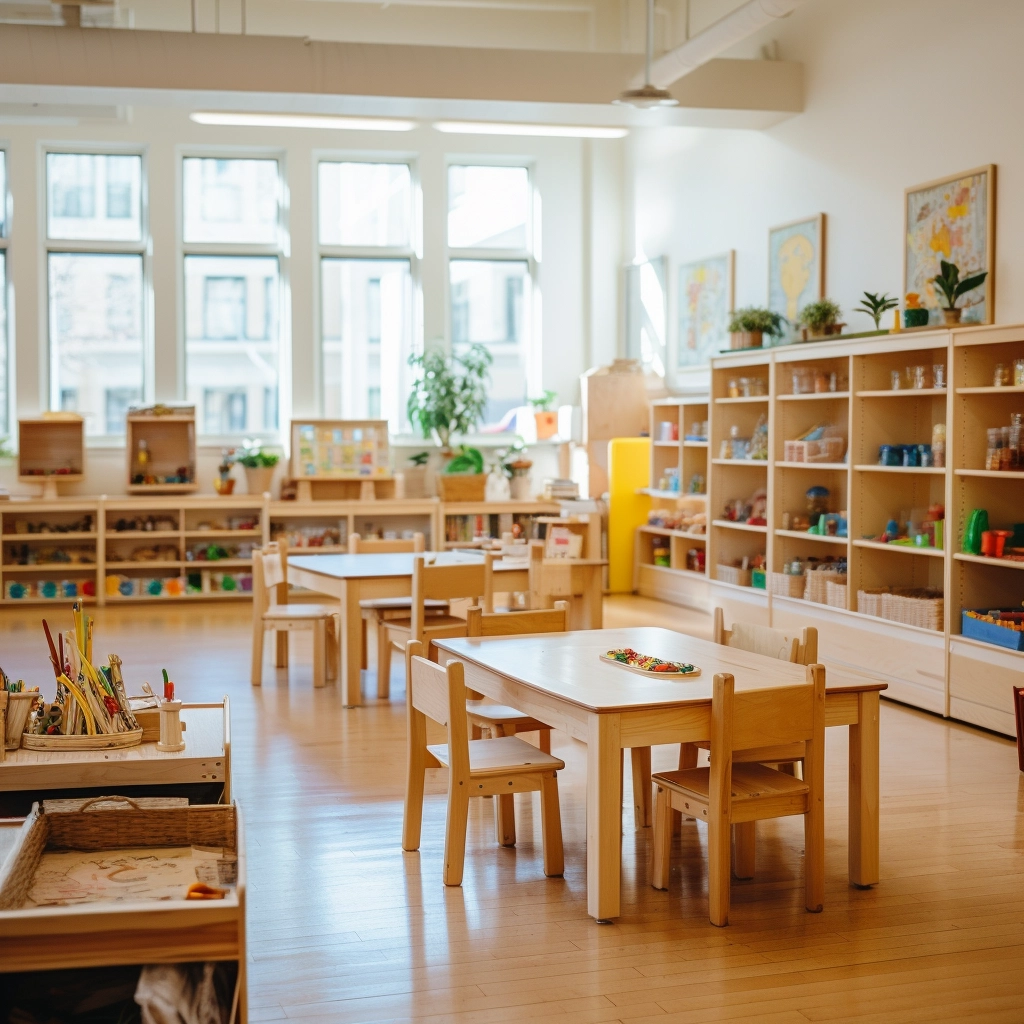If you are a kindergarten teacher, then planning is essential to you. Do you know what classes children like most? Do you understand what skills children need to learn in preschool or kindergarten classes? Most importantly, what does an effective preschool lesson plan look like?
You’re not alone if you’re unsure where to begin or how to structure preschool lesson plans that captivate your students. Many seasoned or new teachers face difficulties designing lesson plans that balance structure and creativity. Without clear guidance, it’s easy to fall into a routine of repetitive activities that fail to engage young learners and leave developmental goals unmet. This can lead to frustration for teachers and students, ultimately impacting the effectiveness of the preschool lesson plans.
この包括的なガイドは、教育基準を満たし、創造性、社会性、そして情緒的成長を育む、ダイナミックで魅力的な就学前教育のレッスンプランを作成するのに役立ちます。実証済みの戦略に従うことで、 遊びに基づく学習多様な発達段階に合わせてアクティビティを調整し、保護者と生徒の双方にとって納得のいくバランスの取れた保育カリキュラムプランを作成します。さあ、一緒にレッスンプランニングのアプローチを変革し、すべての子どもたちが探求と楽しみに満ちた環境で成長できるようお手伝いしましょう!
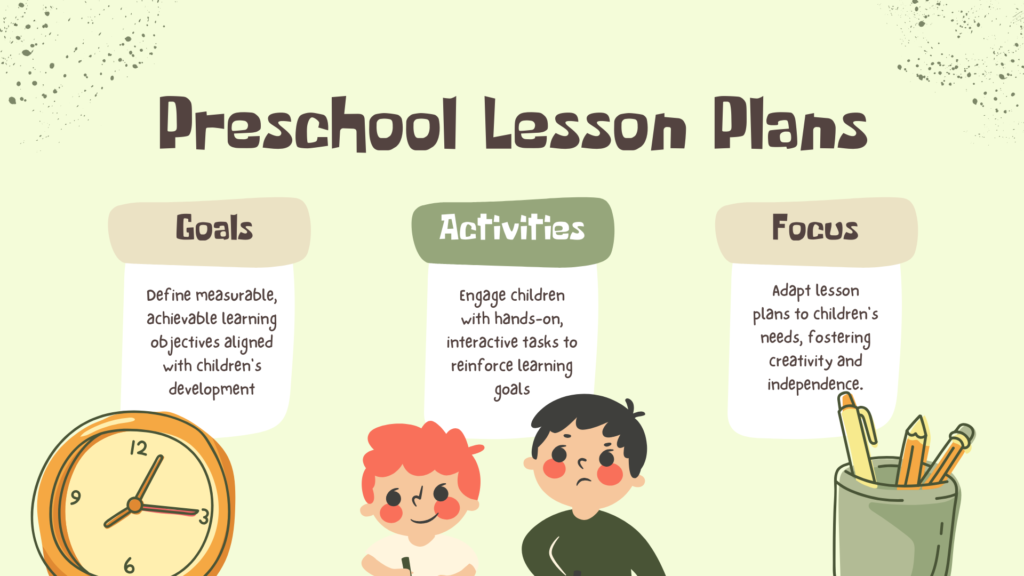
幼稚園向けレッスンプランとは何ですか?
High-quality preschool lesson plans are the backbone of a thriving preschool environment. Well-structured lesson plans set a roadmap for the day, ensuring that young children are engaged, learning, and growing in a nurturing environment. Designed with developmental milestones in mind, these plans support holistic growth by integrating cognitive, social, emotional, and physical learning opportunities.
Beyond structure, preschool lesson plans are a strategic tool for early childhood educators to create engaging, responsive environments. High-quality plans help maintain classroom focus, ensure smooth transitions, and promote consistency, allowing flexibility based on children’s needs and interests. When thoughtfully executed, they foster a rich, nurturing atmosphere where all learners can thrive.
就学前の学習目標
Preschool learning goals are often shaped by early learning standards—guidelines developed by educational authorities to ensure young children acquire the foundational skills needed for long-term academic and social success. These standards cover key developmental domains such as language and literacy, mathematics, physical development, and social-emotional growth. While each region may define its framework (e.g., Head Start Early Learning Outcomes Framework in the U.S.), the core objective remains consistent: to support whole-child development through structured and purposeful learning experiences.
So, what Preschool Learning Goals should preschoolers begin to explore?
必須の学術スキルと概念
学力は、幼稚園における将来の学習の基盤となります。これらの基礎的な学力は、子どもたちに、将来の学習において重要となる基本的な概念を教えます。幼稚園のレッスンプランは、幼い学習者が数字、文字、色、形、基本的なパターンといった基礎概念に慣れ親しむことを目的としています。

- 早期識字能力:未就学児は、文字を認識し、その音を学び、文字に意味があることを理解することで、早期識字能力を身につけ始めます。文字のなぞり書き、アルファベットの歌を歌ったり、簡単な物語を読んだりといった活動は、子どもたちが読書や書き物への愛を育むのに役立ちます。
- 数的思考力:数的思考力は、数を数えること、数字を認識すること、そして「多い」や「少ない」といった基本的な数学の概念を理解することに重点を置いています。物を数えたり、大きさや色で分類したり、簡単な足し算や引き算をしたりするアクティビティを通して、子どもたちは早期に数学のスキルを身につけることができます。
- 形と色:子どもたちは、基本的な形(円、四角、三角)と原色(赤、青、黄)を認識し、名前を覚えます。形と色で物を分類することで、楽しくインタラクティブな方法でこれらの概念を強化することができます。
- パターンと順序:未就学児は、簡単なパターン(例:AB、ABC)と順序(1、2、3)を認識し始めます。ブロックでパターンを完成させたり、絵を描いたりするなどのアクティビティは、論理的思考力と推論力を養うのに役立ちます。
- 時間の概念:未就学児は、「今日」「明日」といった基本的な時間の概念や、一日の区切り(朝、昼、夜)を理解し始めます。カレンダーを使ったアクティビティや、その日の出来事について話し合うといったルーティンを通して、子どもたちは時間の経過を理解しやすくなります。
運動能力
Developing motor skills is crucial for preschoolers’ fine and gross motor development. Fine motor skills focus on using small muscles, such as those needed for holding a pencil, cutting with scissors, or manipulating small objects. Gross motor skills, on the other hand, involve larger muscle groups and are developed through activities like running, jumping, and climbing. Activities like drawing, building with blocks, dancing, and playing outdoors support the development of motor skills, helping children improve coordination, strength, and body awareness.
社会情動的スキル
Social-emotional skills help preschoolers interact with others and manage their own emotions. Children learn to share, take turns, and cooperate through group activities and play. They also begin to understand and express their feelings appropriately. Preschool lesson plans should include activities that teach empathy, self-regulation, and conflict resolution. Role-playing, group discussions, and cooperative games provide opportunities for children to practice these skills, ensuring they develop positive relationships with their peers and a sense of emotional well-being.
認知スキル
認知スキルは、子どもがどのように考え、学び、周囲の世界を理解するかに焦点を当てています。未就学児は、問題解決活動、記憶ゲーム、早期の算数や科学実験を通してこれらのスキルを身につけます。これらの活動は論理的思考を促し、因果関係、分類、類別といった概念を理解するのに役立ちます。さらに、物語を語ったり質問したりすることで言語発達を促すことで、子どもの語彙が増え、周囲の世界について批判的に考える力も養われ、認知能力が向上します。

幼稚園のレッスンプランはなぜ重要なのでしょうか?
就学前教育の効果的な基盤となるのは、就学前レッスンプランです。綿密に練られたレッスンプランは、お子様が学習体験を最大限に活用できるようサポートすると同時に、保護者の皆様の日々の生活にメリハリを与えます。就学前教育は幼児にとって非常に重要な時期であり、提供されるレッスンは、お子様の発達ニーズに応え、学力、社会性、そして情緒面の成長を促すものでなければなりません。
A good preschool lesson plan doesn’t just dictate what children learn—it also focuses on how they learn. It encourages creativity, exploration, and hands-on learning, which are essential for young children. Integrating play, song, art, and sensory activities into your lesson plans addresses multiple learning styles and helps children develop various skills.

幼稚園のレッスンプランの種類
授業計画には様々なアプローチがあり、それぞれに長所と短所があります。どれか一つのアプローチが本質的に優れているということはありません。重要なのは、プログラムのニーズに最も適したものを選択することです。
最も一般的に検討されている方法は、テーマ別カレンダーアプローチとエマージェントカリキュラムアプローチです。以下では、それぞれのアプローチについて詳しく見ていきましょう。
テーマ別レッスンプラン
その テーマ別カレンダーアプローチ 幼稚園のレッスンプランは、月、週、日など、特定の期間に特定のテーマに沿って構成されます。テーマは、動物、季節、祝日、地域の支援者などです。教師は事前に決められたカレンダーに基づいて活動やレッスンを計画し、一度に一つのテーマに焦点を当てるため、非常に体系的なアプローチとなります。
例えば:
- 秋は「収穫」をテーマに、カボチャ、リンゴ、紅葉などのアクティビティが考えられます。
- 冬は「雪」や「冬の動物」に焦点を当て、関連する本、歌、工芸品などを取り入れることができます。
この方法により一貫性が確保され、各テーマが徹底的に検討されることが保証されます。
創発的カリキュラムアプローチ
その 創発的カリキュラムアプローチ より柔軟で、子ども中心のアプローチです。あらかじめ決められたテーマに沿って授業を計画するのではなく、教師は子どもたちの遊び、話し合い、そして興味を観察します。これらの観察に基づいて、教師は子どもたちの好奇心と学習ニーズに合わせて授業計画を調整します。そのため、このアプローチは非常に柔軟で、子どもの学習ニーズに即した、ダイナミックなアプローチとなっています。
例えば:
- 子どもたちが恐竜に興味を持っている場合、教師は恐竜に関する本、美術、数学の練習など、恐竜をテーマにしたアクティビティを紹介するかもしれません。
- 子どもたちが天気について質問したら、先生は天気のパターンや虹について調べるアクティビティを取り入れるかもしれません。
この方法により、より自発的で、自然に進化する子供主導のカリキュラムが可能になります。
How to Implement the Emergent Curriculum Approach
- Observe and Document
Carefully observe children’s play, questions, and interactions. Use notes or photos to record recurring interests or spontaneous curiosity. - Plan Based on Interests
Use the observations to create preschool lesson plans that reflect children’s current interests, integrating literacy, math, art, and science activities. - Facilitate and Adjust
Guide learning through open-ended questions and flexible materials. Continuously adapt plans as new interests emerge, keeping the curriculum dynamic and child-driven.
類似点と相違点
どちらのアプローチも、豊かな学習環境を促進し、さまざまな発達領域にわたって子供たちの学習に取り組むことを目的としていますが、計画、柔軟性、焦点が異なります。
| 側面 | テーマ別カレンダーアプローチ | 創発的カリキュラムアプローチ |
| 計画 | 事前に計画され、特定のテーマを中心に構成されています。 | 子どもたちの自発的な興味やニーズに基づいた柔軟性。 |
| 構造 | 子どもたちの興味が生まれると、流体は進化します。 | 流動的で、子どもたちの興味が生まれるにつれて進化します。 |
| 集中 | 設定された期間内に幅広いトピックをカバーすることに重点を置いています。 | 子どもたちの興味が生まれると、流体は進化します。 |
| 予測可能性 | 設定されたカレンダーまたはタイムラインに沿って固定され、整理されます。 | 自発的かつ反応的で、子どもたちの興味の変化に合わせて適応します。 |
| カリキュラムソース | 事前に決められたテーマとアクティビティに基づいて、教師が主導します。 | 子どもの遊びや交流の観察に基づいた、子ども主導のものです。 |
| 科目統合 | 予測可能かつ体系的であり、各テーマが計画されています。 | 子どもたちの探究心や遊びに基づいて教科を統合します。 |
幼稚園のレッスンプランの作成方法
幼稚園のレッスンプランを作成するには、目標、生徒、そしてリソースを慎重に検討する必要があります。適切に設計されたプランは、有意義な学習体験を促進し、子どもたちの意欲を高め、複数の領域にわたる発達を促します。ここでは、幼稚園のレッスンプランを効果的に作成するためのステップバイステップガイドをご紹介します。
1. Define Your Goals to Create Lesson Plans for Preschoolers
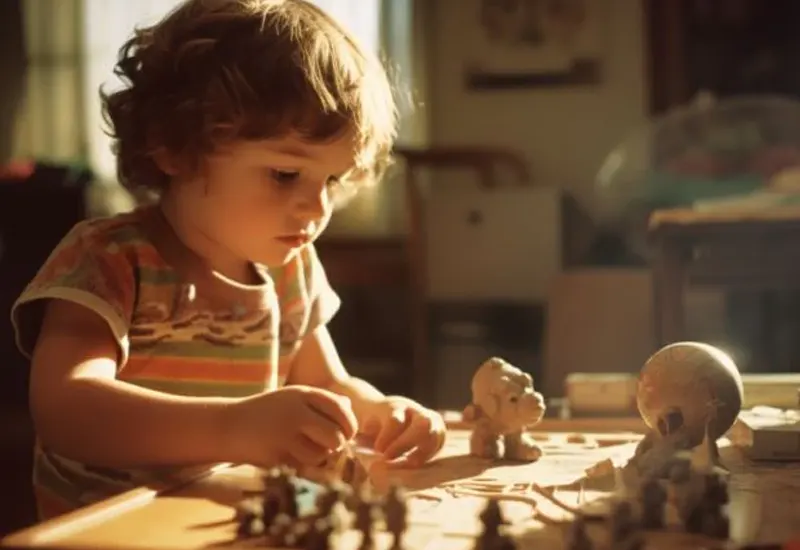
幼稚園のレッスンプランを作成する最初のステップは、明確で測定可能な学習目標を設定することです。これらの目標は、生徒の発達ニーズと一致し、認知、感情、社会性、身体の発達に焦点を当てたものでなければなりません。
年少のお子様の場合、次のような基礎スキルに重点が置かれます。
- 早期識字: 文字、音、簡単な単語を認識します。
- 計算力数を数え、認識し、基本的な数学の概念を理解することを学びます。
- 社会情動的スキル: 共感力、自己制御力、仲間とのコミュニケーション力を養います。
目標は達成可能で柔軟性があり、子どもたちのニーズに合わせて調整できるものであることを確認してください。また、子どもたちの興味を維持し、発達の節目を達成できるよう、目標は年齢に適したものでなければなりません。
2. Know Your Students
指導する年齢層を理解することは、レッスンプランを作成する上で非常に重要です。年齢層によって発達ニーズや集中力は異なるからです。幼稚園のレッスンプランの対象となる年齢層と、それぞれに重点を置くべき点について、以下に詳しく見ていきましょう。
Ages 2-4 Lesson Plans for Nursery School
この年齢の子どもたちは、基本的な運動能力を発達させ、社会的な交流を理解し始めています。以下の点に重点を置きましょう。
- 感覚活動 微細運動能力と粗大運動能力を促進します(例:フィンガーペインティング、ブロックを使った建築)。
- ルーチン構築 子どもたちが構造と遷移を理解できるようにします。
- 言語発達 歌や韻文、簡単な物語を通して。
Ages 3-5 Lesson Plans for Preschool/Pre-K
この段階では、子どもたちは運動能力を磨き、より複雑な社会的交流を始めます。レッスンプランでは、以下の点に焦点を当てる必要があります。
- 早期識字: 文字認識とフォニックスの紹介。
- 数学のスキル: 簡単なカウント、形状認識、パターン識別。
- 創造的な遊び想像力と問題解決能力を刺激する劇遊び、物語、美術工芸。
Ages 4-6 Lesson Plans for Kindergarten
幼稚園児は正式な学校教育への準備をしており、授業計画ではより体系的な活動を取り入れ始める必要があります。重点は以下のとおりです。
- 認知発達: 基本的な加算、減算、単語形成を含む、早期の算数と読解の準備。
- 社会的なスキル: 協力、交代、対立の解決。
- 独立: 自助スキルと個人の責任を奨励します。
各年齢層の発達の節目を理解することで、子どもたちの成長をサポートし、適切に関与できる授業計画を作成することができます。

3. Select Appropriate Materials
適切な材料の選択 幼稚園の学習計画を成功させるには、学習内容が重要です。教育的でありながら、興味を惹く教材を選びましょう。教材のアイデアとしては、以下のようなものがあります。
- おもちゃと教具ブロック、仕分けトレイ、パズルのピースは、細かい運動能力の発達と問題解決に役立ちます。
- 本絵本、簡単な物語、韻を踏む本は、読み書き能力の発達を促します。
- 画材クレヨン、マーカー、粘土、はさみは創造性と運動能力を促進します。
- Musical instruments: Instruments like tambourines or xylophones help with rhythm and auditory learning.
選択する教材が年齢に適切で、安全であり、レッスンの学習目標に役立つものであることを常に確認してください。
4. Write Down Your Lesson Procedures
Once you have clarified your goals and prepared the necessary materials, structure your preschool lesson plan into a logical, sequential flow to ensure smooth transitions and sustained engagement.
Warm-Up & Introduction
Begin by capturing children’s attention and setting the tone for the lesson.
- Start with a short, engaging activity connected to the theme—such as a welcome song, movement game, or visual prompt.
- Ask open-ended questions to stimulate curiosity and connect to prior experiences.
- Clearly state the lesson focus using age-appropriate language.
Core Learning Activity
Guide children through active, hands-on learning that supports the day’s objectives.
- Choose activities encouraging exploration and interaction, such as making themed crafts, role-playing, or storytelling.
- Include multisensory experiences—visual, tactile, auditory, and movement-based—to engage different learning styles.
- Incorporate opportunities for group work and movement to maintain energy and cooperation.
Guided Practice & Extension
Reinforce skills and extend understanding through structured practice.
- Offer short, focused tasks where children apply new knowledge, such as matching games, sorting exercises, or collaborative art.
- Adjust the level of support to meet varying needs, giving extra help to those who need it and challenges to more advanced learners.

5. Assessment and Reflection
最後に、効果的な就学前教育のレッスンプランには、評価と振り返りが不可欠です。この段階では正式な評価は一般的ではありませんが、観察と振り返りは子どもたちの進歩を測るのに役立ちます。以下の戦略を検討してみてください。
- 子どもたちの関わりを観察する活動に積極的に参加していますか?学習目標を達成していますか?
- 観察を記録する: 子どもたちが何ができるか、またどのような点にさらなるサポートが必要かに注目してください。
- 自己反省レッスン後、うまくいった点と改善できる点を振り返りましょう。アクティビティは子どもたちの興味を引きましたか?教材は適切でしたか?このフィードバックを参考に、今後のレッスンプランを調整しましょう。
By continually assessing and reflecting, you can adjust your teaching methods and teaching plan for preschoolers to better meet your students’ needs.
幼稚園のレッスンプランを通じてどのようにお子様をサポートできますか?
お子様の就学前教育のレッスンプランを通してサポートすることは、学習体験を向上させ、教育に対する前向きな姿勢を育むことに繋がります。保護者の皆様は、教室で学ぶスキルや概念を強化する上で重要な役割を担っています。お子様が保育園(2~4歳)、幼稚園・就学前教育(3~5歳)、幼稚園(4~6歳)のいずれであっても、保護者の皆様の関わりは、お子様の学力と人格の発達に大きな違いをもたらす可能性があります。以下に、就学前教育のレッスンプランを通してお子様を積極的にサポートする方法をいくつかご紹介します。
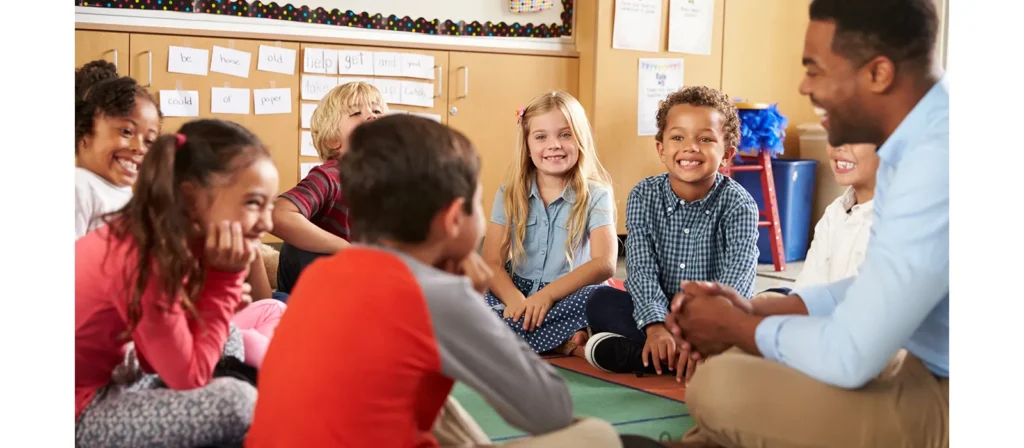
お子様の学習の旅に関わりましょう
お子様の学習に積極的に関わることは、成長をサポートする最も効果的な方法の一つです。学校で毎日学んだことについて話し合うことで、アクティビティに参加することができます。「今日一番楽しかったアクティビティは何だった?」「動物について何を学びましたか?」など、レッスンに関する自由回答形式の質問をすることで、お子様はレッスンを振り返り、理解を深めることができます。こうした会話は、幼稚園のレッスンプランの重要な概念を強化し、コミュニケーション能力の発達に役立ちます。
一貫したルーチンを作成する
就学前のお子様は、規則正しい生活リズムの中で成長します。一貫した生活リズムは、お子様が何を期待されているかを理解し、幼稚園の学習計画に記載されている活動への自信と意欲を高めます。食事の時間、就寝の時間、遊びの時間など、予測可能なルーティンを確立することで、お子様はより安心して、学校での規則正しい学習体験に取り組む準備を整えることができます。
お子様の先生とコミュニケーションをとる
お子様の担任の先生との定期的なコミュニケーションは、幼稚園の学習計画の目的を理解し、ご家庭でどのように強化できるかを理解する上で重要です。先生は、お子様の学習の進捗状況、得意分野、そして直面する課題について、的確なアドバイスを提供してくれます。継続的なコミュニケーションによって、お子様の学習をより効果的にサポートし、ご家庭と学校での活動の一貫性を保つことができます。
自立と責任を奨励する
As children grow, one of the goals of their preschool lesson plan is to develop independence and responsibility. Please encourage your child to complete simple tasks independently, such as putting away their toys, dressing themselves, or helping set the table. These activities promote confidence and help children feel empowered to take ownership of their learning experiences. Reinforcing these skills at home aligns with the broader goals of social-emotional development outlined in the preschool lesson plan.
最後に
Creating effective preschool lesson plans is key to fostering a positive learning environment and supporting the growth and development of young children. Whether you are designing lessons that focus on basic academic skills, motor development, social-emotional growth, or cognitive abilities, the most critical factor is ensuring that your plans are engaging, flexible, and tailored to the needs of the children in your care. Following a structured process, selecting the right materials, and being adaptable to your students’ interests can create an enriching and dynamic learning experience that helps children thrive.
効果的な授業計画は、教室での活動だけにとどまらず、子どもたちが探究心、疑問、成長意欲を掻き立てられるような環境づくりが重要であることを忘れてはなりません。家庭での適切なサポートと教室での思慮深いアプローチがあれば、幼稚園の授業計画は生涯学習の基盤となるでしょう。
で ウェストショア家具私たちは、若い学習者のための育成環境を作ることがいかに重要かを理解しています。 幼稚園用家具20年以上の業界経験を持つ当社は、幼児教育施設のニーズに合わせた高品質で耐久性のある家具を幅広く取り揃えています。教室の設計、カスタム家具のソリューション、製造、品質管理、配送まで、ワンストップサービスをご提供し、機能的で安全、そして創造性を育む空間づくりをサポートします。多様なスタイル、素材、サイズを取り揃えた幼稚園用家具を取り揃えており、あらゆる学習環境を快適で創造性豊かな環境へと最適化します。
FAQ: 幼稚園のレッスンプラン
1. 3~5歳の未就学児に適した毎日の授業計画をどのように設計すればよいでしょうか?
To create effective preschool lesson plans for 3–5-year-olds, start with clear learning goals that align with developmental milestones. Include a balanced mix of academic instruction, creative play, and movement-based activities. A strong plan supports early literacy, number sense, and motor skills while allowing flexibility to adapt based on student responses. Always ensure the plan fosters engagement and follows a predictable daily structure.
2. How can STEAM elements be incorporated into preschool lesson plans?
Preschool lesson plans can integrate STEAM by including hands-on experiences like building towers with blocks, exploring magnets, or mixing colors in art. These activities promote exploration and critical thinking while reinforcing basic math and science concepts. Using open-ended questions and everyday materials helps young learners develop problem-solving and creativity from an early age.
3. 幼稚園のカリキュラムで遊びの時間と学習時間のバランスをとるにはどうすればよいですか?
Preschool lesson plans should strike a balance between structured learning and free play. Plan short, focused sessions for key subjects like math and literacy, followed by time for imaginative or outdoor play. This approach ensures children stay engaged while developing cognitive, social, and physical skills throughout the day. The balance can be adjusted depending on classroom needs and energy levels.
4. 未就学児の社会性を高めるのに効果的なテーマ別アクティビティにはどのようなものがありますか?
Themed preschool lesson plans like “All About Me” or “Community Helpers” create natural opportunities to build social-emotional skills. Through group play, role-playing, and storytelling, children learn to express feelings, take turns, and cooperate. These activities help reinforce classroom expectations and foster positive peer relationships in a developmentally appropriate way.
5. 幼稚園でストーリータイムを通じてインタラクティブなレッスンをどのように設計すればよいでしょうか?
Interactive storytime should be an essential part of preschool lesson plans. Use props, visual aids, and movement cues to bring stories to life and invite participation. Asking open-ended questions throughout the story promotes comprehension and language development. Linking story themes to classroom topics also reinforces vocabulary and makes learning more meaningful.
6. 未就学児の学習の進捗状況を評価し、それに応じて授業計画を調整するにはどうすればよいですか?
Ongoing observation is key to evaluating the effectiveness of preschool lesson plans. Watch how children engage with tasks, noting areas of strength or where support is needed. Use this information to modify future plans—whether that means simplifying instructions, adding challenges, or changing the approach entirely. Regular assessments help ensure each child continues to grow across all learning domains.





